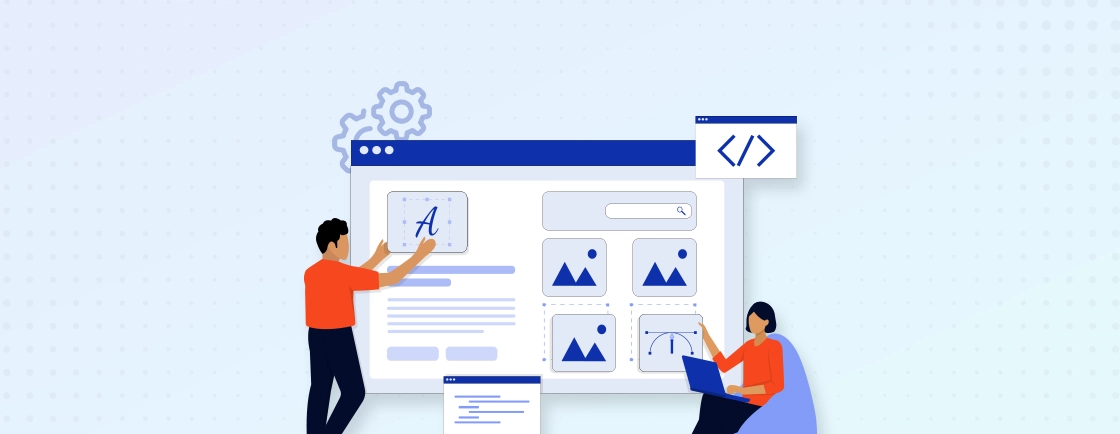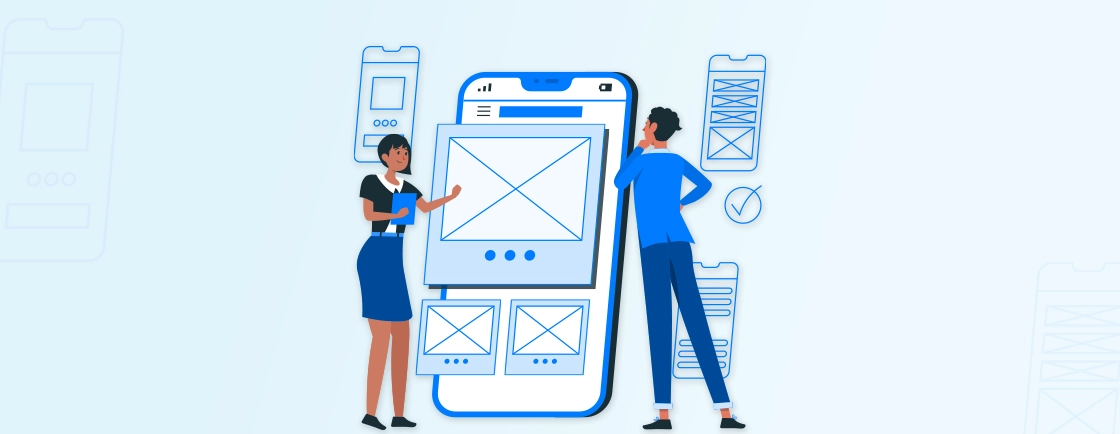Table of Contents
As you may already know, web development is divided into two broad spectrums: frontend and backend. For now, let’s focus on the latter.
Frontend focuses on everything visible to and interacted by the users. That includes everything from the buttons you click to the layouts that guide your eyes. The frontend developers are the architects behind the design, layout, and UI/UX of the site or app.
So what sort of role do the frontend developers play in the web development process? We’ll find out in this blog. But first, let’s see who a frontend developer is.
Who is a Frontend Developer?
A frontend developer specializes in designing and creating the best user interface (UI) and user experience (UX) of websites and web applications. Basically, they create the visible and interactive elements of your site. Whatever you see and interact with on a website or app comes under their domain.
Here’s a breakdown of their key focus:
- User Interface: UI is the layout and appearance of the website or app. It includes the buttons, menus, images, and text. Frontend developers use programming languages like HTML and CSS to design the style and structure of these elements.
- User Experience (UX): UX takes care of the overall experience a user has when interacting with the website or app. Frontend experts aim to make it intuitive and efficient. So the users have an enjoyable experience on the website. The primary factors in focus are usability, responsiveness, and accessibility.
The key responsibility of a frontend developer is to bridge the gap between design and functionality. So beyond the cool features, websites and apps are visually appealing and user-friendly.
What Does a Frontend Developer Do?
As I mentioned, the job of a frontend developer is to build an intuitive UI and ensure an enjoyable user experience. But what does that entail? What are the frontend developer responsibilities? Let’s see.
For User Interface
- Translating designs into code: A crucial responsibility of frontend developer is to collaborate with designers. They convert design mockups and prototypes into functional web pages. For that, they use HTML, CSS, and JavaScript.
- Creating interactive elements: They implement interactive features like buttons, forms, animations, and user input mechanisms. For that, they use the top JavaScript frameworks and libraries. That ensures user engagement and interaction with the website or application.
- Optimizing page performance: They ensure websites load quickly and run smoothly across various browsers and devices. That involves techniques like code optimization, image compression, and efficient resource management.
For User Experience
- Conducting user research: Frontend developers need to understand user needs and behavior. So they can build intuitive interfaces that are target like.
- Implementing accessibility features: They strive to make websites and applications accessible to users with disabilities. For that, they integrate features like image alt texts, keyboard navigation support, etc.
- Testing and iterating: Frontend experts play a vital role in testing the functionality and usability of the website or application. They identify and fix bugs and gather user feedback. That helps them refine the UX based on user interactions and data analysis.
Besides these responsibilities, frontend developers need to work closely with the designers. They ensure the final product aligns with the design vision. Plus, they collaborate with the backend experts to connect the UI with the server-side functionality.
Moreover, these experts need to stay updated on the latest developments in the industry. That includes the top programming languages and web development frameworks. So they can build robust and future-proof applications. Our Hire Frontend Developers offering ensures you work with professionals who stay ahead of industry trends, delivering innovative and scalable solutions for your projects.
Top Technologies Used by the Frontend Developers
Frontend developers need to use a range of powerful technologies to ease the process and improve the final results. Each of them serves a unique purpose and offers outstanding advantages. Let’s take a look at some of the most popular ones.
- HTML (HyperText Markup Language): The backbone of web development, HTML provides the structure for web pages by defining the content and layout.
- CSS (Cascading Style Sheets): CSS is used to style HTML elements, controlling their appearance, layout, and design. CSS frameworks like Bootstrap, Foundation, and MaterializeCSS are popular for rapidly building responsive and visually appealing websites.
- JavaScript (JS): JavaScript is the primary programming language for frontend development. It enables dynamic and interactive behavior on web pages, such as animations, form validation, and DOM manipulation. Popular frameworks and libraries include:
- React.js: Developed by Facebook, React.js is a powerful library for building user interfaces, known for its component-based architecture and virtual DOM.
- Angular: Developed and maintained by Google, Angular is a comprehensive framework for building large-scale, single-page web applications.
- Vue.js: Vue.js is a progressive JavaScript framework that is lightweight and easy to integrate into existing projects, offering a flexible and approachable solution for frontend development.
- jQuery: Although its usage has declined with the rise of modern frameworks, jQuery remains relevant for simplifying DOM manipulation and event handling.
- Responsive Design: With the proliferation of mobile devices, responsive design has become essential. Technologies like CSS Grid and Flexbox facilitate the creation of layouts that adapt to different screen sizes and orientations.
- CSS Preprocessors: Tools like Sass and Less extend CSS with features like variables, mixins, and nested rules, making CSS code more maintainable and efficient.
- Build Tools: Build tools like Webpack, Parcel, and Rollup to automate tasks such as bundling, minification, and transpilation, streamlining the development process and optimizing performance.
- Version Control Systems: Version control systems like Git are indispensable for collaborative development, enabling developers to track changes, manage branches, and collaborate seamlessly.
- Frontend Testing: Testing frameworks like Jest, Mocha, and Jasmine facilitate the testing of frontend code, ensuring its reliability and robustness.
- Progressive Web Apps (PWAs): PWAs leverage modern web technologies to deliver app-like experiences on the web, including features like offline functionality, push notifications, and smooth performance. Frameworks like Workbox and PWACompat aid in building PWAs.
- WebAssembly (Wasm): WebAssembly is a binary instruction format. It enables high-performance computation in web browsers. So frontend developers can run complex applications at near-native speeds. It can be integrated with languages like C/C++, Rust, and Go to extend the capabilities of web applications.
The frontend development services select the technologies or stacks based on the project requirements. The aim of these technologies is to streamline the web application development process as much as possible. Our Front End development company leverages these cutting-edge tools to deliver tailored, high-performing web solutions that align with your unique business goals.
Soft Skills You Need to be a Frontend Developer
Technical expertise is crucial for any frontend developer to create the best applications. But a major part of this domain works on soft skills. Frontend experts need to have some interpersonal qualities to effectively communicate and collaborate on the projects. These skills ensure the best results and client satisfaction as well.
Some of the key soft skills that a good frontend developer should have include:
- Clear and Concise Communication: A frontend developer needs to convey technical concepts to clients and team members effectively. And it should be clear to both technical and non-technical audiences. That ensures everyone concerned is on the same page.
- Active Listening: Pay close attention to feedback from designers and other team members. That helps them understand their needs and concerns.
- Collaboration: Work effectively with team members from various disciplines. It fosters a collaborative environment that values diverse perspectives.
- Critical Thinking: Analyze technical challenges, identify root causes, and develop innovative solutions. So every feature and functionality works smoothly.
- Adaptability: Embrace change and readily learn new technologies and frameworks to be updated with the evolving landscape.
- Troubleshooting: Identify and resolve technical issues efficiently. That minimizes downtime and ensures user satisfaction.
- Meticulousness: Write clean, well-organized code that is easy to understand and maintain for oneself and others.
- Quality Assurance: Pay close attention to detail to identify and address potential bugs and defects before they impact users.
- Pixel-perfect Execution: Ensure visual elements are aligned perfectly and maintain consistency throughout the user interface.
- Prioritization: Effectively prioritize tasks, manage deadlines, and juggle multiple projects simultaneously without compromising quality.
- Organization: Stay organized and maintain a clear understanding of project requirements and ongoing tasks.
- Self-motivation: Take ownership of your work and be proactive in managing your time and workload.
- Empathy: Understand and consider the perspectives of designers, back-end developers, and users to create a user-centric and well-rounded final product.
- Teamwork: Foster a collaborative and supportive environment. They need to work with team members to achieve common goals.
- Conflict resolution: Address disagreements constructively and offer solutions that benefit the project and the team.
A frontend developer needs to hone these soft skills along with the technical expertise. That way, they can build the best functional websites and apps effectively.
FAQs on Frontend Developer Responsibilities
Do frontend developers need to know design principles?
Not all frontend developers are designers themselves. But it would be great to know the basic design principles like layout, typography, and color theory. So they can translate design mockups into functional code.
Is responsiveness important in today’s web development?
Responsiveness is critical. It ensures websites and applications adapt seamlessly to different screen sizes and devices. With the rise of mobile browsing, frontend developers need to prioritize creating responsive user experiences.
What are the career growth opportunities for frontend developers?
Frontend developers can progress into various roles, including:
– Senior Frontend Developer
– Frontend Lead/Architect
– Full-stack Developer
– UI/UX Designer
Conclusion
Frontend domain of web development is quite dynamic and ever-evolving. So those with technical expertise can create visually appealing and user-centric experiences. They can translate designs into code to ensure user satisfaction through intuitive UIs.
A frontend developer’s roles and responsibilities go beyond technical prowess. They should also collaborate effectively, communicate clearly, and solve problems creatively. They need to continuously hone your skill set and embrace the challenges and opportunities.
Need help creating user-friendly interfaces and experiences for your website? Then consult with our frontend development company today!





